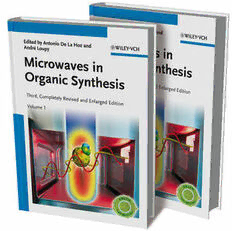
Microwaves in Organic Synthesis, 2 Volume Set PDF
Preview Microwaves in Organic Synthesis, 2 Volume Set
Editedby AntoniodelaHozandAndre´Loupy MicrowavesinOrganicSynthesis RelatedTitles SeriesEditor:Anastas,P.T. Kappe,C.O.,Dallinger,D.,Murphree,S.S. VolumeEditors:Boethling,R.,Voutchkova, PracticalMicrowave Synthesis A.,Li,C.-J.,Perosa,A.,Selva,M.(eds.) forOrganicChemists Handbook ofGreenChemistry- Strategies,Instruments,andProtocols GreenProcesses 2009 3-VolumeSet ISBN:978-3-527-32097-4 2012 ISBN:978-3-527-31576-5 Bogdal,D.,Prociak,A. Microwave-EnhancedPolymer Gruttadauria,M.,Giacalone,F.(eds.) ChemistryandTechnology Catalytic Methods in Asymmetric Synthesis 2007 AdvancedMaterials,Techniques, ISBN:978-0-8138-2537-3 andApplications 2011 ISBN:978-0-470-64136-1 Edited by Antonio de la Hoz and Andre´ Loupy Microwaves in Organic Synthesis Third, Completely Revised and Enlarged Edition Volume 1 TheEditors AllbookspublishedbyWiley-VCHare carefullyproduced.Nevertheless,authors, editors,andpublisherdonotwarrantthe Prof.AntoniodelaHoz informationcontainedinthesebooks, UniversidaddeCastilla-laMancha includingthisbook,tobefreeoferrors. FacultaddeQu´ımica Readersareadvisedtokeepinmindthat DepartamentodeQu´ımicaOrga´nica statements,data,illustrations,procedural 13071CiudadReal detailsorotheritemsmayinadvertentlybe Spain inaccurate. Dr.Andre´Loupy Universite´Paris-Sud LibraryofCongressCardNo.:appliedfor LaboratoiredesRe´actionsSe´lectivessur Supports BritishLibraryCataloguing-in-Publication Batiment410 Data 91405OrsayCedex Acataloguerecordforthisbookisavailable France fromtheBritishLibrary. Bibliographicinformationpublishedbythe DeutscheNationalbibliothek TheDeutscheNationalbibliothek liststhispublicationintheDeutsche Nationalbibliografie;detailedbibliographic dataareavailableontheInternetat <http://dnb.d-nb.de>. 2012Wiley-VCHVerlag&Co.KGaA, Boschstr.12,69469Weinheim,Germany Allrightsreserved(includingthoseof translationintootherlanguages).Nopart ofthisbookmaybereproducedinany form–byphotoprinting,microfilm,orany othermeans–nortransmittedortranslated intoamachinelanguagewithoutwritten permissionfromthepublishers.Registered names,trademarks,etc.usedinthisbook, evenwhennotspecificallymarkedassuch, arenottobeconsideredunprotectedbylaw. PrintISBN:978-3-527-33116-1 ePDFISBN:978-3-527-65134-4 ePubISBN:978-3-527-65133-7 mobiISBN:978-3-527-65132-0 oBookISBN:978-3-527-65131-3 CoverDesign Grafik-DesignSchulz, Fußgo¨nheim Typesetting LaserwordsPrivateLimited, Chennai,India PrintingandBinding MarkonoPrintMedia PteLtd,Singapore Printedonacid-freepaper V Contents toVolume 1 Preface XIX ListofContributors XXI PartI FundamentalAspectsofMicrowaveIrradiationinOrganic Chemistry 1 1 Microwave–MaterialsInteractionsandDielectricProperties:from MoleculesandMacromoleculestoSolidsandColloidalSuspensions 3 DidierStuerga 1.1 FundamentalsofMicrowave–MatterInteractions 3 1.1.1 Introduction 4 1.1.1.1 History 4 1.1.1.2 TheElectromagneticSpectrum 7 1.1.1.3 WhatAboutChemistry:EnergeticComments 8 1.1.2 TheComplexDielectricPermittivity 11 1.1.2.1 EffectofRealPart:PolarizationandStorageofElectromagnetic Energy 14 1.1.2.2 EffectofImaginaryPart:DielectricLosses 18 1.1.2.3 ThermalDependenceoftheDielectricPermittivity 26 1.1.2.4 ConductionLosses 28 1.1.2.5 MagneticLosses 30 1.2 DielectricPropertiesandMolecularBehavior 30 1.2.1 DielectricPropertiesWithinaComplexPlane 30 1.2.1.1 ArgandDiagram 30 1.2.1.2 Cole–ColeModel 31 1.2.1.3 Davidson–ColeModel 32 1.2.1.4 Glarum’sGeneralization 33 1.2.1.5 MoleculeswithTwoorMorePolarGroups 33 1.2.2 DielectricPropertiesofCondensedPhases 33 1.2.2.1 PureLiquids:WaterandAlcohols 34 1.2.2.2 EffectsofElectrolytes 35 1.2.2.3 IntermolecularInteractionsandComplexes 37 1.2.2.4 IntermolecularInteractionsandHydrogenBonding 38 VI Contents 1.2.2.5 WhatIsNewAboutBoundWater? 38 1.2.3 DielectricPropertiesofMacromoleculesandPolymers 40 1.2.3.1 MacromoleculesandPolymers 40 1.2.3.2 HighlyFunctionalInorganic–PolymerComposites 41 1.2.4 DielectricPropertiesofSolidsandAdsorbedPhases 43 1.2.4.1 SolidsandDipoleRelaxationofDefectsinCrystalsLattices 43 1.2.4.2 SolidsandAdsorbedPhases 44 1.2.5 DielectricPropertiesofInterfacesandColloidalSuspensions 45 1.2.5.1 InterfacialRelaxationandtheMaxwell–WagnerEffect 45 1.2.5.2 Colloids 46 1.3 Conclusion 50 References 51 2 DevelopmentandDesignofReactorsinMicrowave-Assisted Chemistry 57 BerndOndruschka,WernerBonrath,andDidierStuerga 2.1 Introduction 57 2.2 BasicConceptsforReactionsandReactorsinOrganicSynthesis 58 2.3 MethodsforEnhancingtheRatesofOrganicReactions 59 2.4 Microwave-AssistedOrganicSyntheses 61 2.4.1 MicrowaveOvensandReactors – Background 63 2.4.1.1 Applicators,Waveguides,andCavities 63 2.4.1.2 Single-ModeorMulti-Mode? 64 2.4.1.3 LimitsofDomesticOvens 65 2.4.1.4 TemperatureMeasurementLimits 65 2.4.1.5 DesignPrinciplesofMicrowaveApplicators 65 2.4.2 Scale-UpofMicrowaveCavities 66 2.4.3 EfficiencyofEnergyandPower 67 2.4.4 FieldHomogeneityandPenetrationDepth 68 2.4.5 ContinuousTubeReactors 69 2.4.6 MAOS – anInterdisciplinaryField 69 2.5 CommercialMicrowaveReactors 70 2.5.1 MarketOverview 70 2.5.2 Enterprises’Products 71 2.5.3 SAIREM’sProducts 74 2.5.3.1 TheLABOTRONSeries 74 2.5.3.2 TheLABOTRONHTEandi-WASP 76 2.5.3.3 TheMiniLABOTRON 77 2.5.3.4 TheMiniflow 78 2.6 SelectedEquipmentandApplications 79 2.6.1 HeterogeneousCatalysis 82 2.6.2 HyphenatedTechniquesinCombinationwithMicrowaves 83 2.6.2.1 MicrowaveOvenCascade 83 2.6.2.2 PhotoconversionsbyUseofMicrowave–UVMethods 84 2.6.2.3 Microwaves–Ultrasound 85 Contents VII 2.6.3 CombinationofMicrowaveIrradiationwithaPressureSetup 85 2.6.3.1 TheRAMOSystem 88 2.6.3.2 TheNaxagorasTechnologyPilotPlant 89 2.6.3.3 SupercriticalMicrowaveReactor 90 2.6.3.4 TheCoconutReactor 91 2.6.4 SynthesisofLaurydone 92 2.6.5 IndustrialEquipment:BatchorContinuousFlow? 93 2.6.5.1 TheTurbosphereSystem 93 2.6.5.2 ThePulsarSystem 93 2.6.5.3 TheThermostarSystem 95 2.7 QualificationandValidationofReactorsandResults 96 2.8 ConclusionandtheFuture 97 References 98 3 KeyIngredientsforMasteryofChemicalMicrowaveProcesses 105 DidierStuergaandPierrePribetich 3.1 TheSystemicApproach 105 3.2 ThermalDependenceofDielectricLoss 108 3.2.1 ThermalDependenceofDielectricProperties 109 3.2.2 MicrowaveBistability 110 3.3 ElectricFieldEffects 111 3.3.1 PenetrationandSkinDepths 111 3.3.2 DimensionalResonances 113 3.4 LoopModesorStrangeSolutionsofMaxwell’sEquations 114 3.5 HydrodynamicAspects 116 3.6 ThermodynamicandOtherEffectsofElectricFields 117 3.7 AthermalandSpecificEffectsofElectricField 118 3.8 TheThermalPathEffect:AnisothermalConditions 120 3.9 HotSpotsandHeterogeneousKinetics 122 3.10 Conclusion 123 References 124 4 NonthermalEffectsofMicrowavesinOrganicSynthesis 127 LaurencePerreux,Andre´Loupy,andAlainPetit 4.1 Introduction 127 4.2 OriginofMicrowaveEffects 128 4.3 SpecificNonthermalMicrowaveEffects 130 4.4 EffectsoftheMedium 134 4.4.1 PolarSolvents 134 4.4.2 NonpolarSolvents 136 4.4.3 Solvent-FreeReactions 138 4.5 EffectsDependingonReactionMechanisms 140 4.5.1 IsopolarTransition-StateReactions 141 4.5.2 BimolecularReactionsBetweenNeutralReactantsLeadingtoCharged Products 144 VIII Contents 4.5.3 AnionicBimolecularReactionsInvolvingNeutralElectrophiles 145 4.5.4 UnimolecularReactions 146 4.6 EffectsDependingonthePositionoftheTransitionStateAlongthe Reactioncoordinate 146 4.7 EffectsonSelectivity 147 4.8 SomeIllustrativeExamples 150 4.8.1 BimolecularReactionsBetweenNeutralReactants 151 4.8.1.1 NucleophilicAdditionstoCarbonylCompounds 151 4.8.1.2 MichaelAdditions 164 4.8.1.3 S 2Reactions 166 N 4.8.1.4 AromaticandVinylicNucleophilicSubstitutions 172 4.8.1.5 Solvent-FreeSynthesisofNewOxoazetidines 174 4.8.2 BimolecularReactionswithOneChargedReactant 175 4.8.2.1 AnionicS 2ReactionsInvolvingCharge-LocalizedAnions 175 N 4.8.2.2 AnionicS 2ReactionsInvolvingCharge-DelocalizedAnions 180 N 4.8.2.3 NucleophilicAdditionstoCarbonylCompounds 182 4.8.2.4 ReactionsInvolvingPositivelyChargedReactants 185 4.8.3 UnimolecularReactions 188 4.8.3.1 ImidizationReactionofaPolyamicAcid 188 4.8.3.2 CyclizationReactions 189 4.8.3.3 IntramolecularNucleophilicAromaticSubstitution 190 4.8.3.4 IntramolecularMichaelAdditions 191 4.8.3.5 DeprotectionofAllylEsters 192 4.8.3.6 SynthesisofPyrido-FusedRingSystems 193 4.8.3.7 Ring-ClosingAlkeneMetathesis 193 4.8.4 SomeIllustrativeExamplesoftheEffectsonSelectivity 194 4.8.4.1 Benzylationof2-Pyridone 194 4.8.4.2 AdditionofVinylpyrazolestoImineSystems 194 4.8.4.3 StereoControlofβ-LactamFormation 195 4.8.4.4 CycloadditiontoC Fullerene 195 70 4.8.4.5 SelectiveAlkylationof1,2,4-Triazole 196 4.8.4.6 RearrangementofAmmoniumYlides 197 4.9 ConcerningtheAbsenceofMicrowaveEffects 198 4.10 Conclusion:SuitableConditionsforObservationofSpecificMW Effects 199 References 200 5 SelectivityModificationsUnderMicrowaveIrradiation 209 A´ngelD´ıaz-Ortiz,AntoniodelaHoz,Jose´Ramo´nCarrillo,andMar´ıa AntoniaHerrero 5.1 Introduction 209 5.2 SelectiveHeating 210 5.2.1 Solvents 210 5.2.2 Catalysts 211 5.2.3 Reagents;MolecularRadiators 214 Contents IX 5.2.4 Susceptors 215 5.3 ModificationofChemoselectivityandRegioselectivity 218 5.3.1 ProtectionandDeprotectionofAlcohols 218 5.3.1.1 ElectrophilicAromaticSubstitution 219 5.3.2 SynthesisandReactivityofHeterocyclicCompounds 221 5.3.2.1 CycloadditionReactions 225 5.3.2.2 Polymerization 228 5.3.2.3 Miscellaneous 230 5.4 ModificationofStereo-andEnantioselectivity 234 5.5 Conclusion 240 Acknowledgments 240 References 240 6 ElucidationofMicrowaveEffects:Methods,Theories,andPredictive Models 245 AntoniodelaHoz,A´ngelD´ıaz-Ortiz,Mar´ıaVictoriaGo´mez, PilarPrieto,andAnaSa´nchezMigallo´n 6.1 Introduction 245 6.2 ThermalEffects 246 6.2.1 EliminationofWallEffectsCausedbyInvertedTemperature Gradients 246 6.2.2 Overheating 247 6.2.3 ‘‘HotSpots’’:Inhomogeneities 249 6.3 Non-ThermalEffects 256 6.3.1 ReactionsandTheories 257 6.3.1.1 Photochemistry.TripletState 257 6.3.1.2 RadicalReactions 258 6.3.1.3 PolymerizationReactions 258 6.3.1.4 EnzymesandNaturalProducts 264 6.3.1.5 HeterogeneousReactions.Diffusion 266 6.3.2 MethodstoElucidatetheOccurrenceofNon-ThermalMicrowave Effects 271 6.3.2.1 MicrowaveIrradiationwithSimultaneousCooling 271 6.3.2.2 DevelopmentofMixedReactors 274 6.3.2.3 UseofSiliconCarbideVessels 277 6.3.2.4 Reactionsat1GHz 279 6.3.2.5 RamanSpectroscopy 279 6.3.2.6 ConductivityMeasurements 280 6.3.2.7 ComputationalCalculations 281 6.4 Conclusion 291 Acknowledgments 291 References 291 X Contents 7 MicrowaveSusceptors 297 ThierryBessonandC.OliverKappe 7.1 Introduction 297 7.2 GraphiteasaSensitizer 299 7.2.1 Diels–AlderReactions 299 7.2.2 EneReactions 304 7.2.3 OxidationofPropan-2-ol 305 7.2.4 ThermolysisofEsters 306 7.2.5 ThermalReactionsinHeterocyclicSyntheses 307 7.2.5.1 SynthesisofQuinazolinesandDerivatives 308 7.2.5.2 BenzothiazolesandDerivatives 310 7.2.5.3 Synthesisof2H-Benzopyrans(Coumarins) 312 7.2.6 DecomplexationofMetalComplexes 313 7.2.7 RedistributionReactionsBetweenTetraalkyl-orTetraarylgermanes andGermaniumTetrahalides 314 7.2.8 PyrolysisofUrea 315 7.2.9 EsterificationofStearicAcidbyn-Butanol 316 7.3 GraphiteasSensitizerandCatalyst 316 7.3.1 AnalysisofTwoSyntheticCommercialGraphites 317 7.3.2 AcylationofAromaticCompounds 318 7.3.3 AcylativeCleavageofEthers 322 7.3.4 KetodecarboxylationofCarboxylicDiacids 323 7.4 TheUseofSiliconCarbideSusceptorsinMicrowaveChemistry 326 7.4.1 SiliconCarbideasPassiveHeatingElement 326 7.4.2 SiliconCarbideReactionVessels 332 7.4.3 MicrotiterPlatesMadefromSiliconCarbide 337 Acknowledgments 340 References 340 8 ToolsforMonitoringReactionsPerformedUsingMicrowave Heating 347 NicholasE.Leadbeater,JasonR.Schmink,andTrevorA.Hamlin 8.1 Introduction 347 8.2 WatchingMicrowave-HeatedReactionsinRealTime 348 8.2.1 UseofaDigitalCameraInterfacedwithaScientificMicrowave Unit 348 8.2.2 UseofThermalImagingEquipment 350 8.3 MonitoringMicrowave-HeatedReactionsUsingInSituSpectroscopic Tools 353 8.3.1 Introduction 353 8.3.2 RamanSpectroscopy 354 8.3.2.1 Introduction 354 8.3.2.2 QualitativeReactionMonitoring 356 8.3.2.3 QuantitativeReactionMonitoring 359 8.3.2.4 ProbingNon-ThermalMicrowaveEffects 363
